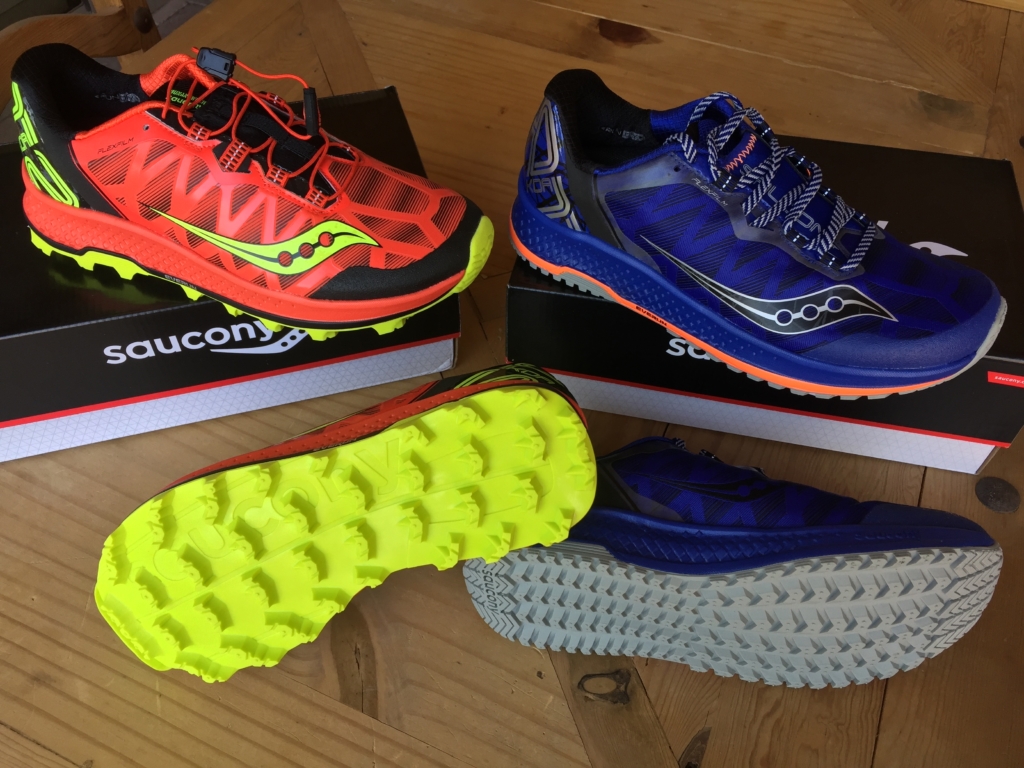
Men's Saucony KOA ST and Saucony KOA TR
Mud Run Guide is always looking for the next great option for you and your obstacle racing needs. Recently we caught wind of the KOA series from Saucony, a brand not well known as an OCR go to shoe. We were intrigued by the KOA ST as it says “MUD” on the side of the shoe. Any shoe that has the word MUD on it intrigues both Brett and Margaret. How could it not?!?
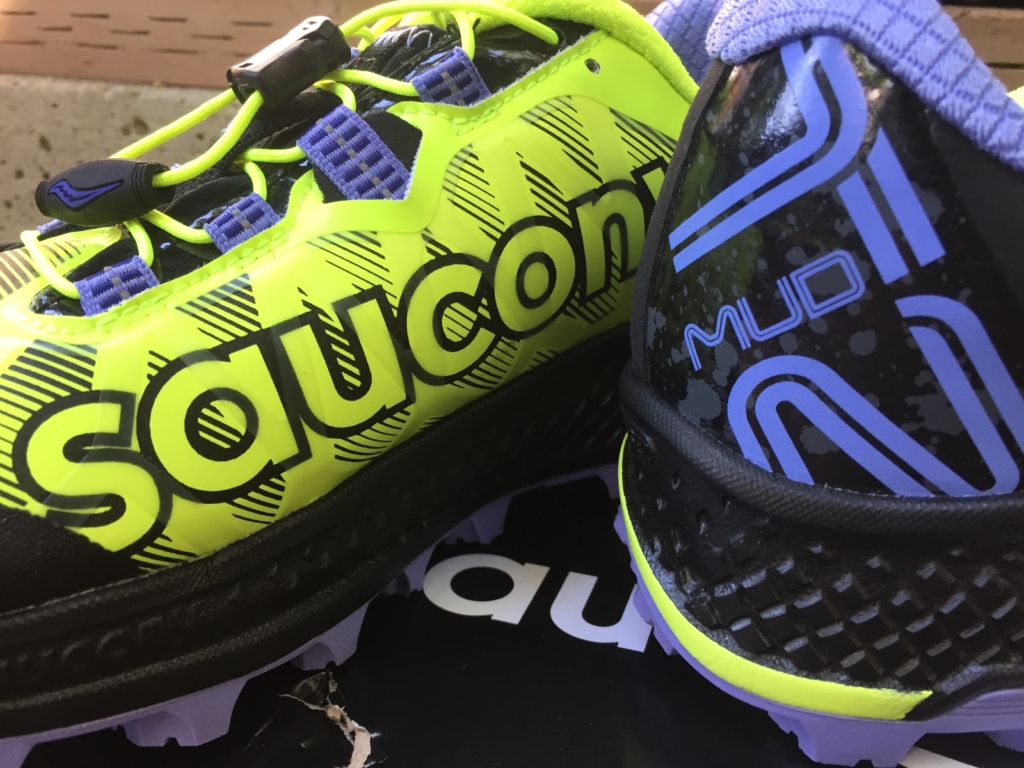
Women's KOA ST
We reached out to Saucony asking to give the KOA ST a review and they sent both Brett and Margaret not only the Saucony KOA ST but also the Saucony KOA TR to test in the process. With Brett in Arizona and Margaret between Vermont and New York, it gave us a variety of conditions to test this trail running shoe (including finding natural obstacles in the words and water). Brett and Margaret independently took the shoes out for a couple runs and product tests and these are their thoughts.
Saucony KOA TR
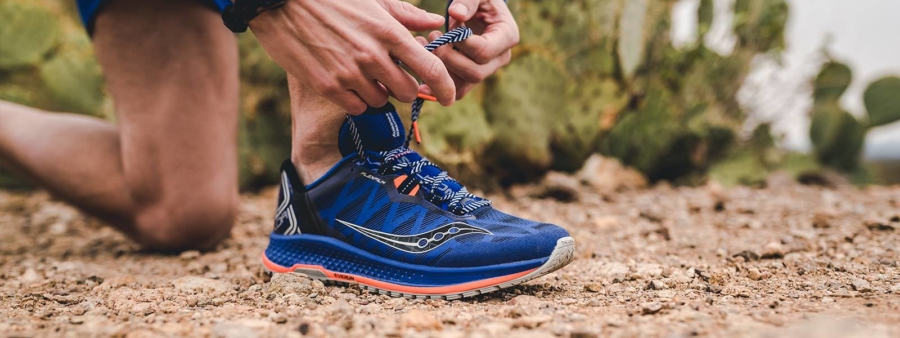
What Saucony says:
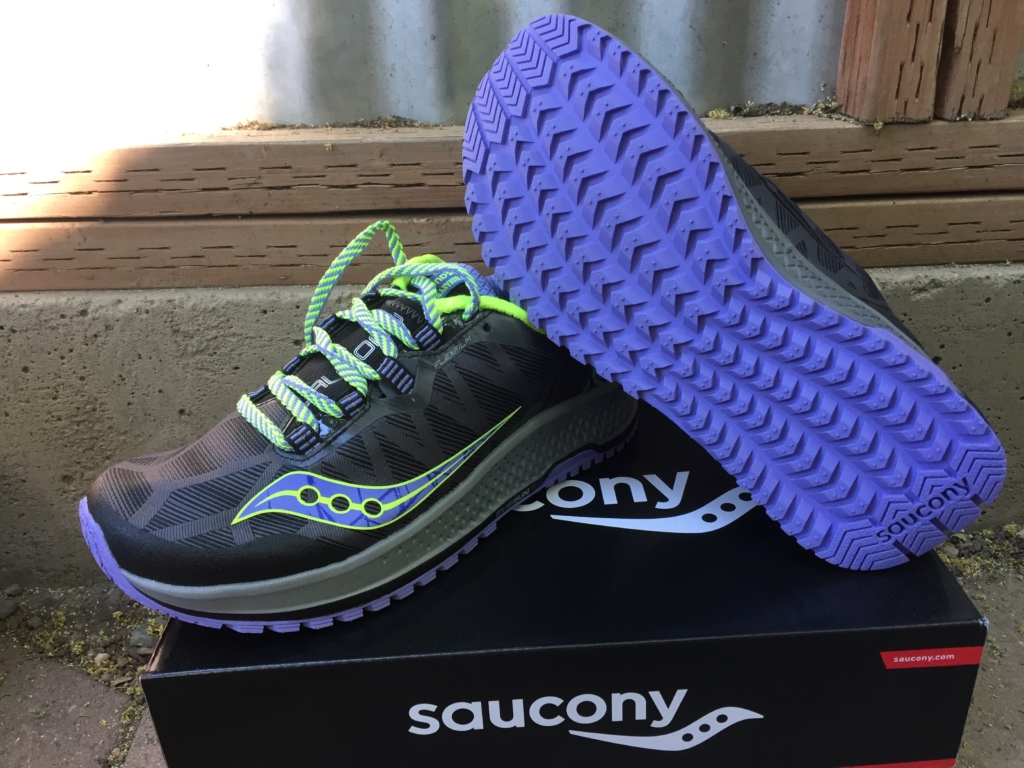
Women's Saucony KOA TR
PRODUCT DETAILS
OVERVIEW
- Men's KOA TR
- Ultra-grippy PWR TRAC outsole with lower (3.5mm) tread pattern for a great road-to-trail feel
- Oblique toebox allows for maximum splay at toe-off for added stability
- 3mm EVERUN topsole construction for continuous cushioning throughout the run
- Durable, woven upper mesh for added protection
- Reinforced heel piece for protection and a lockdown fit
SPECS
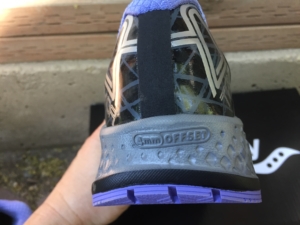 Shoe Category: Trail
Shoe Category: Trail
Arch: Normal (Mid)
Offset: 4mm
Heel Stack Height: 22mm
Forefoot Stack Height: 18mm
Weight: 10.3 oz. | 292 g.
MSRP: $110.00
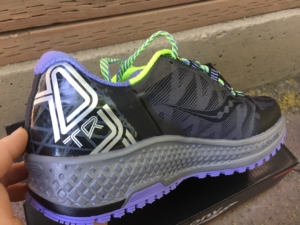 CUSHIONING: The underfoot feel and the amount of impact protection provided by the compressing materials between the foot and running surface.
CUSHIONING: The underfoot feel and the amount of impact protection provided by the compressing materials between the foot and running surface.
SUPPORT: The level of pronation control built into the shoe. Pronation is the inward rolling of the ankle through the gait cycle.
OFFSET: The difference in height between the heel thickness and forefoot thickness of the shoe.
Our Review:
Brett & Margaret took the Saucony KOA TR and KOA ST out on the roads and trails to put them through their paces. Margaret is an Inov-8 aficionado (running in nearly every style since 2011) and Brett most often runs in the Icebug Oribi.
Brett's First Impressions:
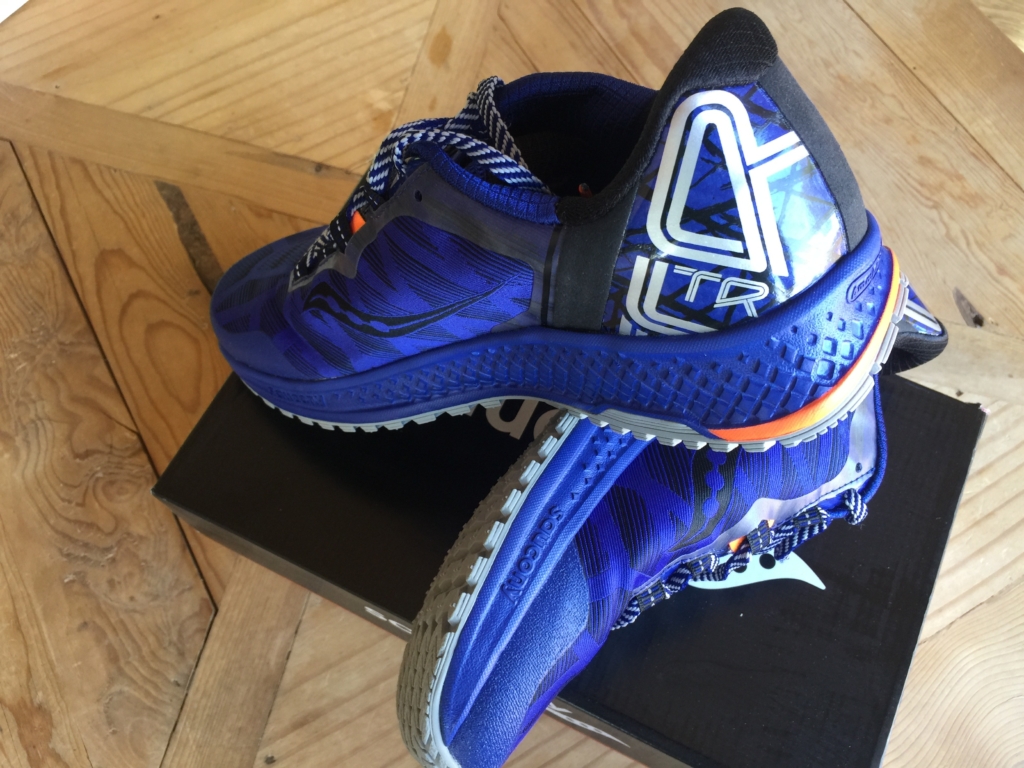 Upon opening the box the KOA TR is an attractive shoe, and I was intrigued by the tread style for light trail and on-road use. The stack height (22mm) is pretty high with lots of foam, a 4mm heel-toe offset is appealing to me as I'm not a fan of “wedge” shoes with an 8mm or larger offset.
Upon opening the box the KOA TR is an attractive shoe, and I was intrigued by the tread style for light trail and on-road use. The stack height (22mm) is pretty high with lots of foam, a 4mm heel-toe offset is appealing to me as I'm not a fan of “wedge” shoes with an 8mm or larger offset.
The tongue and heel cup feature plenty of padding, the heel itself is quite rigid for a neutral shoe, and most likely adds to the weight of the shoe without providing any benefit for a neutral runner. The toebox seems wide, and I expected ample space – if not a little excess room – when I slipped them on and was surprised to find less forefoot volume than I expected.
The stretchy poly membrane connecting eyelets provides a snug fit, and the laces seem less for shoe retention and more for fine-tuning. The independent 3rd lace stay connects directly to the midsole, allowing an extremely snug fit for those who prefer to have no space around their midfoot. With a pair of Mudgear 1/4 crew socks (my 100% go-to sock for all shoe testing, training, and racing) I immediately experienced a tight, yet comfortable fit that required just a little playing around with the slightly chunky laces to get dialed in.
Margaret's First Impressions:
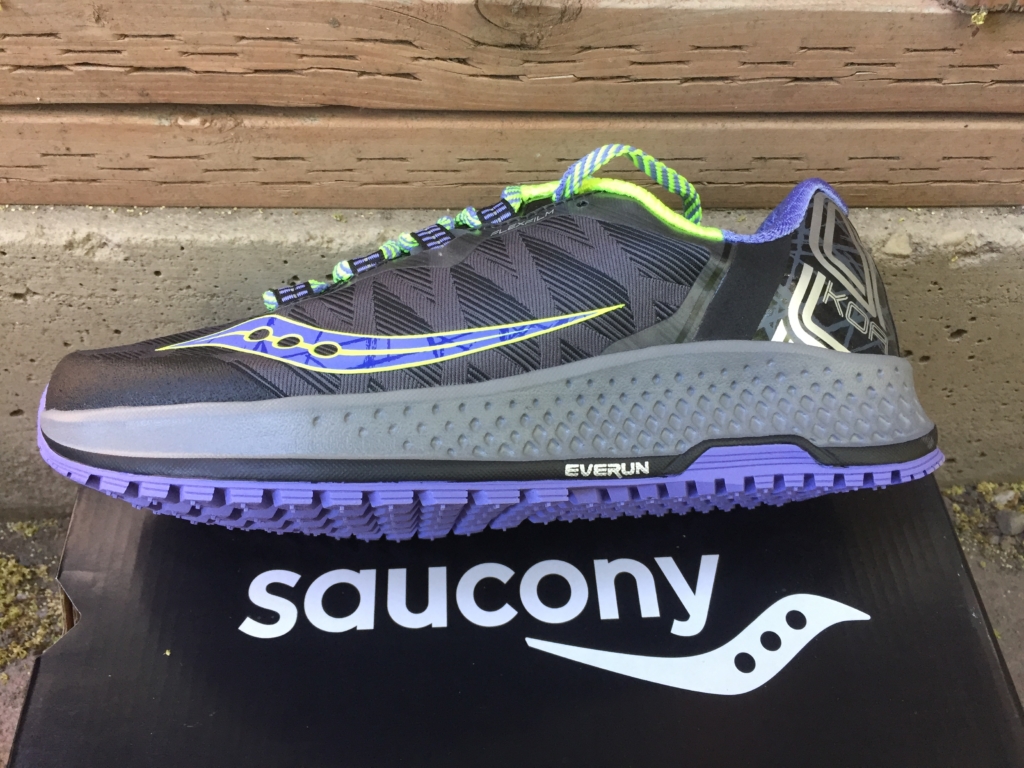 Holy shoe! This is a lot more shoe than what I have been running in for years. The colors are good, I like the black and purple and neon accents together. The lugs, at first sight, are nothing special and it seems like a flatter sole. I really like the laces as they are easier to double knot for race day.
Holy shoe! This is a lot more shoe than what I have been running in for years. The colors are good, I like the black and purple and neon accents together. The lugs, at first sight, are nothing special and it seems like a flatter sole. I really like the laces as they are easier to double knot for race day.
The upper material looks like it will stand up to the rigors of an OCR. The shoe reminds me of a Scott shoe I ran in years ago. I would put it in the same category as a Brooks Cascadia or Salomon Speedcross 4 series.
I first tried them on with my go to sock of Injinji's and they fit great. I like the space in the toebox for my wider/blockier feet. They were way less bulky feeling on than just looking at them out of the box. These are a size 8 shoe, my normal running shoe size. I have worn a women's size 8 in Inov-8's, Icebug, Altra, Reebok, Hoka, Scott, and Salomon. My day to day shoe size for Luna's and Tom's (my only other shoes) are 7.5 for reference.
Brett's Run Test:
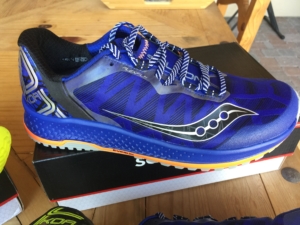 The Saucony KOA TR‘s showed up just-in-time to be my shoe of choice for passing the 500-mile mark in my #5keveryday running streak, and although my miles were on the road (in record-breaking 118º AZ heat), the tread and cushioning felt right at home on the pavement. With their snug fit, I had to adjust my right laces and sock a few times to get comfortable, but they felt relatively responsive if just slightly less cushioned than I expected.
The Saucony KOA TR‘s showed up just-in-time to be my shoe of choice for passing the 500-mile mark in my #5keveryday running streak, and although my miles were on the road (in record-breaking 118º AZ heat), the tread and cushioning felt right at home on the pavement. With their snug fit, I had to adjust my right laces and sock a few times to get comfortable, but they felt relatively responsive if just slightly less cushioned than I expected.
The Saucony TR's are rated as “firm and responsive” and I did find the ride to be a little harsher than other running shoes with a similar “max foam” concept and considerable stack height. I am assuming a few more runs will soften them just a bit and get into that sweet spot where they are cushy in the sole yet snug-fitting – right where I'd love these shoes to be, and they will surely find more road and light trail usage if they get there.
Margaret's Run Test:
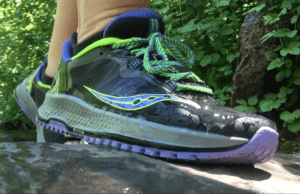 I laced up and heading up into one of the canyons above Salt Lake City to take these on a test run on the trails, road, water, and more. I ran on mostly pavement, packed trails, some off-piste hills, a boardwalk, and of course a few river crossings, and logs.
I laced up and heading up into one of the canyons above Salt Lake City to take these on a test run on the trails, road, water, and more. I ran on mostly pavement, packed trails, some off-piste hills, a boardwalk, and of course a few river crossings, and logs.
My goal was to get some miles and test them in conditions that could mimic obstacle racing. For me, the shoes were pretty responsive and transitioned well from pavement to boardwalk to a packed trail and finally off the trail. My heel locked in nicely and my toes had ample room to move where needed. The shoe is wide enough for my foot and my feet had a comfortable ride on the trail.
For a shoe that looked bulky to me, it did not feel like that when running. It is not a super lightweight shoe but is light enough for most racers. Elite racers looking for podiums it might be too much shoe for you. It had just enough grip on all the trails. When I got off trail in loose dirt I slid a little but it was too be expected. However, the fun came when I got into the water. After making sure the shoes were good and wet (standing in a moving river for a few minutes) trekked through some murky water as well as light rapids. I stepped out of the river and watched the water ooze out of the uppers as I ran and walked. I traversed a rather slick rock in the river and found the shoes to grip as most other OCR shoes will do. I put in a couple miles and felt comfortable saying adding this shoe to the list of possible OCR contenders.
The lugs were enough for my testing conditions however on an extremely muddy course racers will probably want a more aggressive lug on the bottom of the shoe.
Who do I think this shoe is for?
Many in the OCR world complain that they need more support in an obstacle racing shoe than many of the current models on the market. Saucony comes in to help fill the gaps that brands like Reebok, Icebug, Inov-8 and others create for those who need the support. Athletes who are used to running in a Brooks, or Salomon Speedcross 4 will like the Saucony KOA TR.
Saucony KOA ST
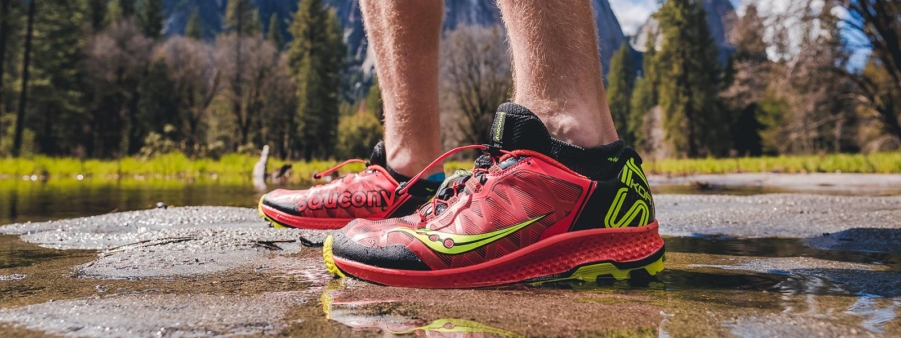
What Saucony says:
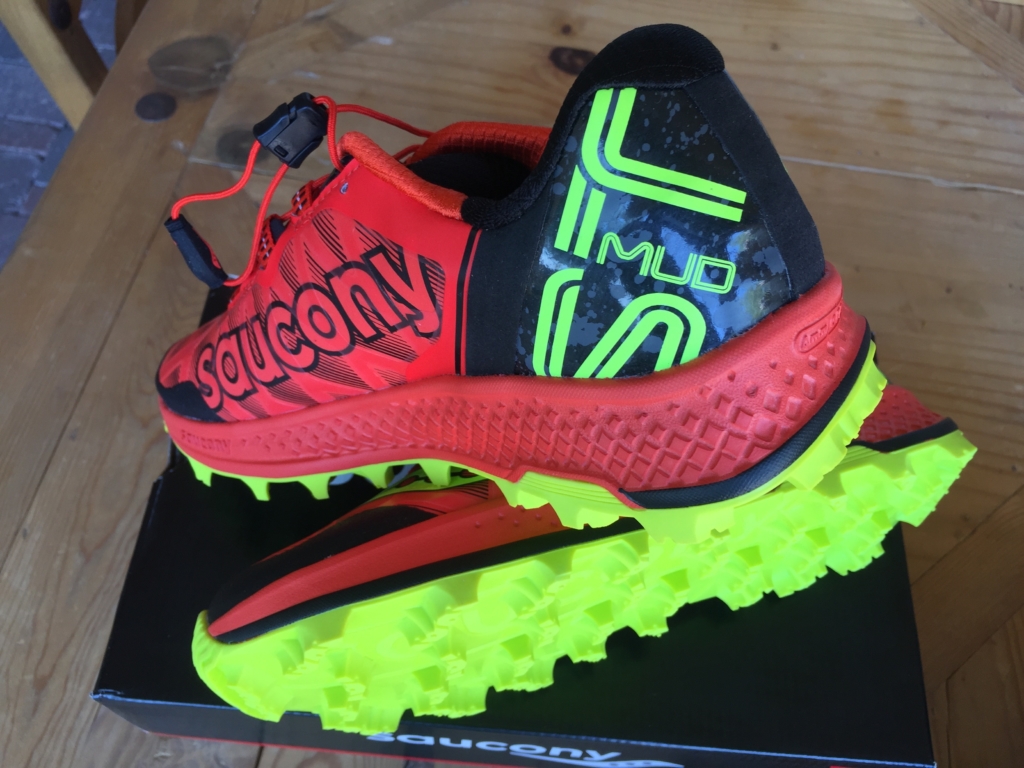
Men's Saucony KOA ST
PRODUCT DETAILS
OVERVIEW
- Deep stud pattern (8mm) deliver surefootedness across soft, muddy terrains
- Oblique toebox allows for maximum splay at toe-off for added stability
- 3mm EVERUN topsole construction for continuous cushioning throughout the run
- Durable, synthetic upper sheds mud and moisture to keep the foot dry
- Reinforced heel piece for protection and a lockdown fit
SPECS
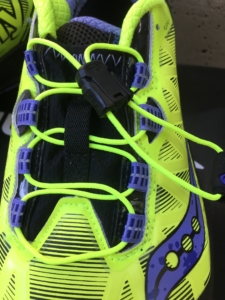
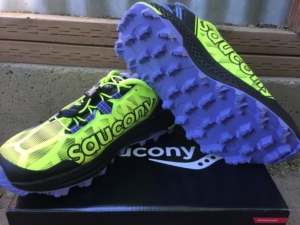
Women's KOA ST
Shoe Category: Trail
Offset: 4mm
Heel Stack Height: 22mm
Forefoot Stack Height: 18mm
Weight: 10.3 oz. | 292 g.
MSRP: $130
Brett's First Impressions:
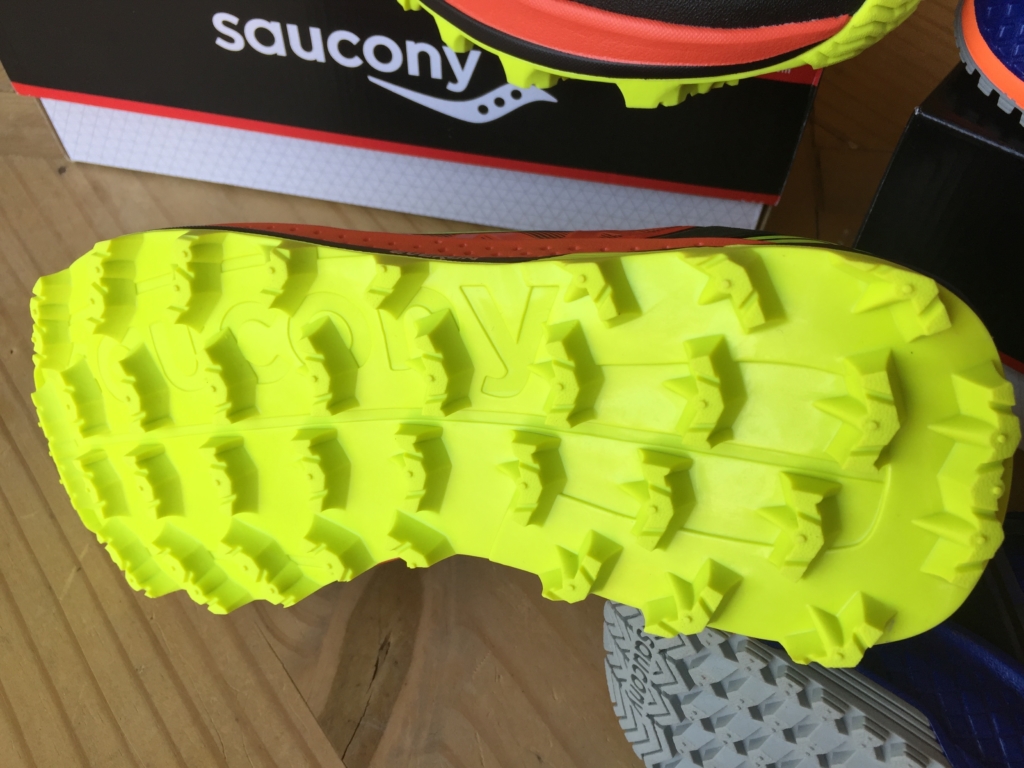 “Wow, it looks like Saucony is getting serious about an aggressive trail shoe!” (more details) Unfortunately for me, the upper materials are slightly less flexible than the KOA TR, and after 2 hours of general wearing and light jogging, my toenails absolutely ached.
“Wow, it looks like Saucony is getting serious about an aggressive trail shoe!” (more details) Unfortunately for me, the upper materials are slightly less flexible than the KOA TR, and after 2 hours of general wearing and light jogging, my toenails absolutely ached.
It wasn't because my toes were ramming into the end of the shoe – although they were closer than I would've liked – the tension of the upper above the toe box didn't give my toes anywhere at all to move and the upper was tight against my toenails causing discomfort.
I'll update this section when I receive a size 10 (.5 size up from my standard 9.5 US) and am able to test. Trust me, I wanted to like the shoes and can appreciate the look, materials, and technology – they were just unbearable tight on the tops of my toes in my standard size.
Margaret's First Impressions:
These are some serious lugs! This looks like an OCR shoe from the box. The construction, design, overall look is rugged and has the visual queues of a great OCR shoe in the making. Still, a lot more shoe than I am used to but let's give it a try.
I'll admit I first tried them on in the parking lot of the trail being taking them for a run in the woods. Again wearing Injinji lightweight socks. My first impression putting them on was much different from Brett's again they fit my foot really well. The wider design gave my foot all the room it needed yet cupped in all the right places. Out of the box, I was on a couple mile run.
Margaret's Test Run:
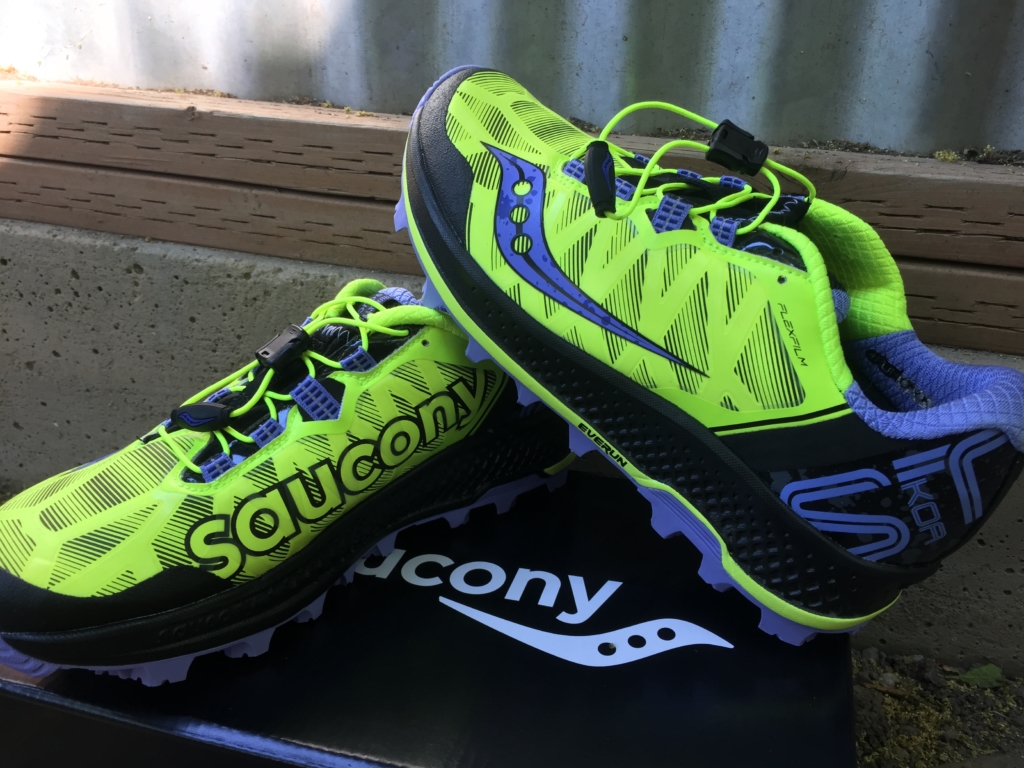 My goal was to test as many elements I could that mimicked obstacle racing in one run. This included bushwhacking up and down a stupidly steep hill, multiple times to get a video shot, river crossings, primitive log bridges, packed pavement, climbing, crawling, and of course normal running.
My goal was to test as many elements I could that mimicked obstacle racing in one run. This included bushwhacking up and down a stupidly steep hill, multiple times to get a video shot, river crossings, primitive log bridges, packed pavement, climbing, crawling, and of course normal running.
I started on the pavement to see how the lugs would feel and they felt similar to any other OCR shoes with aggressive lugs on the pavement, no surprise. The ride was smooth on my feet and the extra padding was nice for the basic trail running sections.
Where the shoe really excelled was when I got off the packed trail and onto some stupidly steep loose dirt terrain. The aggressive lugs helped me power up the trail and kept me from slipping on the way down. I really give Saucony credit in this department. It seemed the shoe adapted to any obstacle or terrain I threw at it.
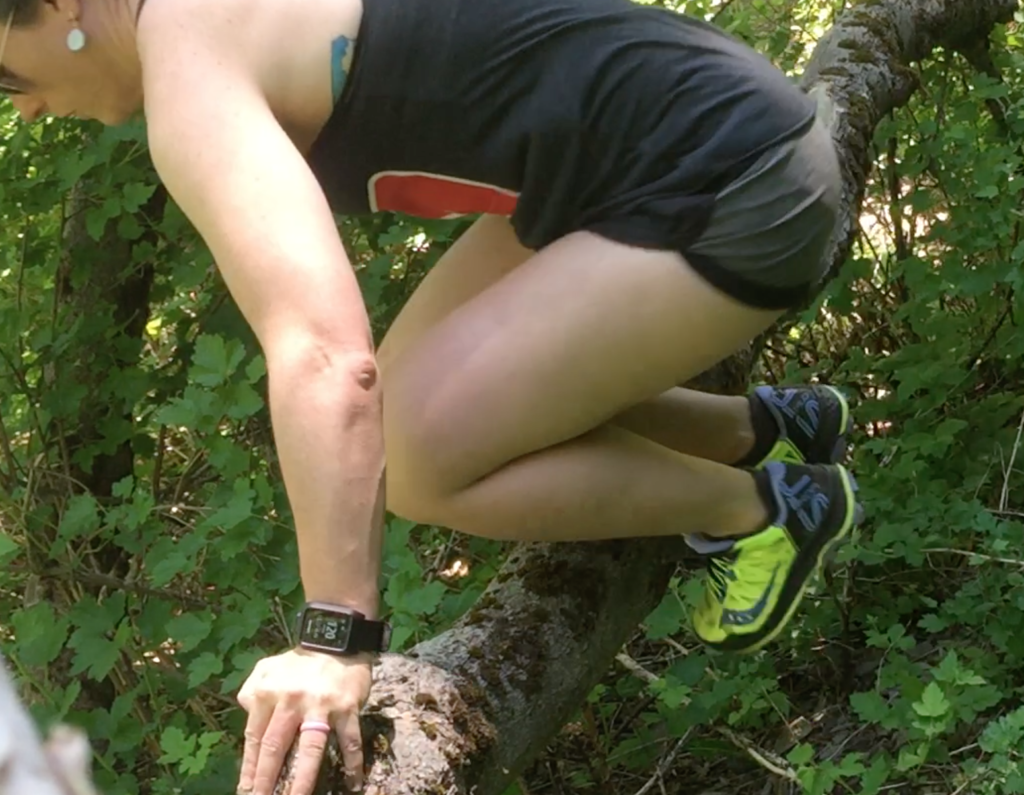 The Saucony KOA ST handled well on an uneven primitive log bridge someone built over the river. It gripped on wood and rocks. Then came the all-important water test. Pretty much the litmus test for an OCR shoe. This is where the KOA ST and the KOA TR were completely different. Again I stood in the river and let the shoes get really wet, mucked around in some murky water, and basically tried to get them in the worse water conditions I could find.
The Saucony KOA ST handled well on an uneven primitive log bridge someone built over the river. It gripped on wood and rocks. Then came the all-important water test. Pretty much the litmus test for an OCR shoe. This is where the KOA ST and the KOA TR were completely different. Again I stood in the river and let the shoes get really wet, mucked around in some murky water, and basically tried to get them in the worse water conditions I could find.
The KOA ST upper is great for shedding mud and water when it is on the outside of the shoe, however, the upper is not really breathable. So while the upper does not soak up water like a sponge it also was not the best as expelling the water. That being said, it is comparable to other uppers that are built similarly. While the shoe did get heavier out of the water after a few minutes 90% of the water had released itself from the shoe. So I would not rule out this as an OCR option, however taking note of the drainage it is something worth considering.
Who is this shoe for?
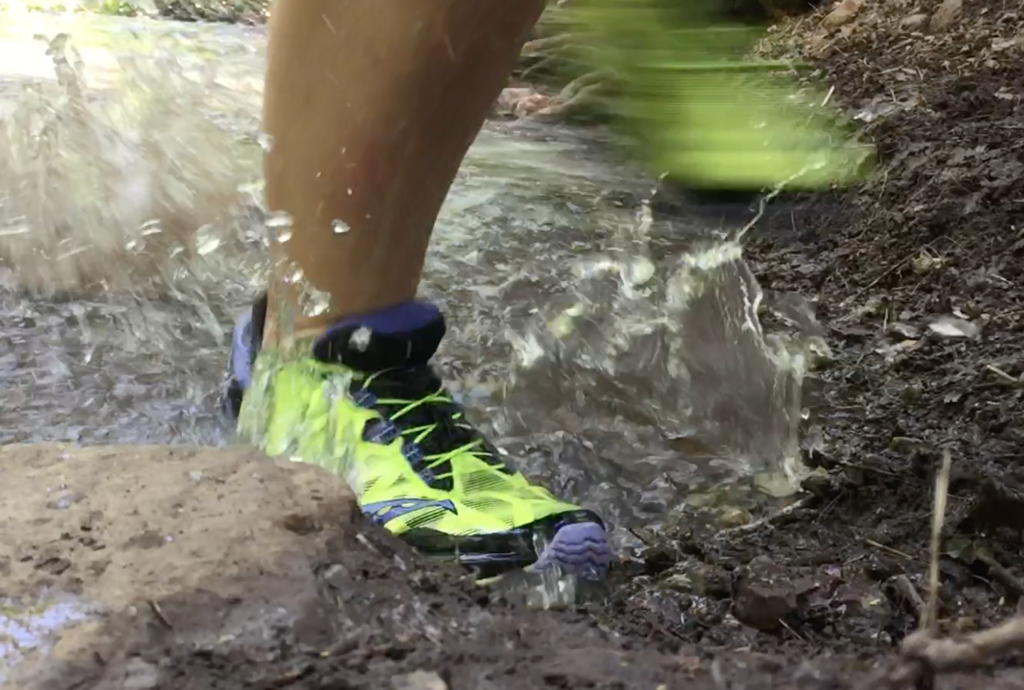 Again this shoe I see in the same market space at those who are used to Brooks or a cushier Salomon. They are for the athlete who needs more support on the trail than most of the current more minimal options. They offer superior traction that will get you through any terrain on an obstacle course. You can easily “toe into” wall and other obstacles with the shoe.
Again this shoe I see in the same market space at those who are used to Brooks or a cushier Salomon. They are for the athlete who needs more support on the trail than most of the current more minimal options. They offer superior traction that will get you through any terrain on an obstacle course. You can easily “toe into” wall and other obstacles with the shoe.
This shoe will get you through the roughest terrain. On a drier course, it will be great. For a race with a lot of mud, the drainage is a consideration when buying. Overall, this could be a decent OCR shoe for the right race.
Note: Our feedback on these shoes is based on our years of running, our running style, and our own two feet. While we make every attempt to be objective, our experiences are ours alone, and one size may not fit all – in fact, we're positive it doesn't.


Thanks for the reviews of these, your review helped convince me the KOA ST were the shoe for me for serious mud running, it was very difficult to find a trail shoe that is comfortable, grips the muds and with a wider toe box.
Hi! Great review!
I must ask you something. I own a pair of KOA ST and have been through the exact same as you, very tight up front although they are my number/size. I have do ditch the insoles for something thiner in order to accommodate my feet, otherwise they were unusable and couldn’t get a bigger size.
I love the TR specs and they are perfect for what I need at the moment, but I am afraid of sizing. From your experience there is a little more space on the TR than ST? I can only assume Saucony makes the ST very tight as they are intended for mud/snow and a tight fit shoe gives better security…
Thank you in advance.